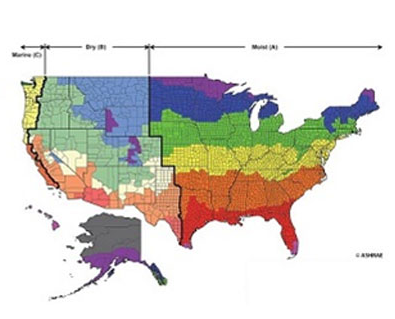Industry Trends5 min
De-Coding Climate Zones: Planning Resilient Construction
While sustainability is continuing its reign as a key purchase consideration for homebuyers, we're seeing indications that "resiliency" is trending for 2022. Resilient construction is about intentionally building for both sustainability and strength perspectives. Essentially, a well-built resilient home is constructed to withstand adverse natural and manmade disasters. In fact, the Urban Land Institute defines resilience construction as "the ability to prepare and plan for, absorb, recover from, and more successfully adapt to adverse events."
Resilient Building for Location
While it's daunting to prepare for every natural disaster Mother Nature throws at you, one way builders are planning resilient construction is by examining climate zone maps and considering best practices for resilient building for location. Climate zones are one way builders can predict the types of weather they'll need their structures to resist.
Every three years, the International Code Council (ICC) updates several codes, including the International Energy Conservation Code (IECC). The IECC climate zone map was developed to provide a simplified, consistent approach to defining climate for implementation of various codes.
In 2003, with direction from the Building America teams, researchers at the Department of Energy’s National Renewable Energy Laboratory simplified the U.S. IECC map into eight climate zones. They are defined by the number of heating degree days, average temperatures and precipitation:
Hot-humid
Mixed-humid
Hot-dry
Mixed-dry
Cold
Very-cold
Subarctic
Marine
In the latest December 2020 release, about 10 percent of all U.S. counties shifted to a warmer climate zone. These counties represent some highly populated, metropolitan areas that are experiencing considerable construction activity.
Building for Climate Zones with Better Energy Efficiency
Builders rely on climate zones to know what energy codes and standards to follow. However, as resiliency comes to mind, homes should strive to meet the challenges of the climate where they are built. To do this, it's a good idea to make sure you're using the newest climate zone map.
"Resiliency will always mean different things to different people because nature's threats are geographically specific," says Craig Miles, Director of OSB Sales & Marketing at LP Building Solutions. "Phoenix has high heat, whereas Texas has high heat and strong winds. Florida and the Carolinas have moisture-rich humidity and salt. The Plains and Midwest have storms and straight-line winds, while the North has below-freezing temperatures."
Using the climate zone map to determine building materials helps achieve a certain measure of confidence. "Building materials that are resilient may give you a more predictable series of outcomes as well as the ability to withstand weather and other external threats," says Miles.
For example, to guard against the hot, beating sun, LP® TechShield® Radiant Barrier may help your air conditioning be more effective and may also help lower your energy costs to a more predictable level, especially in climate zones 1–4. For climate zones that experience moist and humid conditions, LP Legacy® Premium Sub-Flooring guards against moisture threats––even hard rain before the roof goes up––while adding floor strength.
The climate zone map dictates many of the energy-efficiency measures buildings must use and are especially relevant to the building envelope.
For more about resilient construction no matter where you live, read “How to make your builds more weather-resistant.”
Learn how to stay up-to-date on building regulations or take a deep dive into green building codes today.

Continue Reading
Resiliency Solutions
5 minIntroducing LP® SmartSide® ExpertFinish® Naturals Collection™: Nature-Inspired Beauty Meets Engineered Performance
We’re excited to introduce the LP® SmartSide® ExpertFinish® Naturals Collection™, a bold new addition to our trusted line of engineered wood siding and trim that delivers the warmth and beauty of nature with the advanced protection and performance builders and homeowners expect.
Labor Solutions
5 minChoosing the Right LP® Structural Solutions Product for Your Build
When it comes to building strong, reliable, and high-performing structures, the materials you choose matter. At LP Building Solutions, we understand that every project, whether it's a single-family home or a multifamily development, requires structural components that meet your needs for strength, durability, and efficiency.
Sustainability Solutions
5 minBuilding a More Sustainable Future with LP Building Solutions
In today's world, sustainability is no longer just a buzzword, it's a blueprint for responsible living and smarter building. As the construction industry seeks ways to reduce its environmental footprint, LP Building Solutions is focused on providing innovative building materials for eco-conscious builders to help reshape what it means to build sustainably
News & Stories3 min
History of Partnership with Gary Sinise Foundation
The LP Foundation is a proud partner of the Gary Sinise Foundation, which supports wounded veterans in several ways. You can learn more about the LP Foundation here.